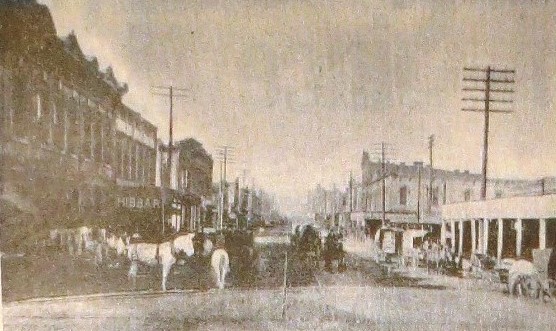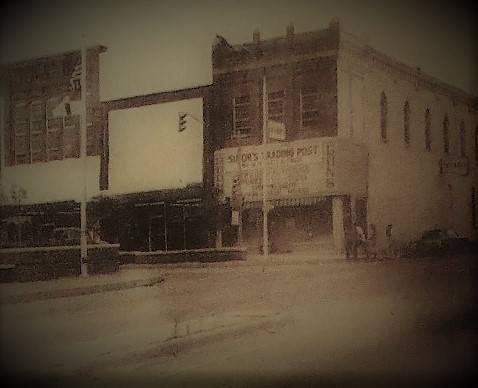|
Denison Herald July 27, 1972 FIRST BIRTHDAY REPORT GAVE GRAPHIC PICTURE OF CITY
Tents First Marked Site (Editor's Note - Written for the Denison Daily News for Denison's first birthday, September 23, 1873, the following article by Harrison Tone, one of Denison's "charter:" citizens, reviews the city's first year of feverished building activity that started with the sale of the first lots one year earlier.) By Harrison Tone One year ago today the city of Denison was in a chaotic, unorganized state, a thing wholly of the future. All told, there were perhaps 50 men who had gathered upon the town site, and along the little rise which now marks the alley between Owings and Morgan streets had erected booths, tents, and in half a dozen cases, temporary box houses in which they had already commenced business. Here in a single row were Brown with his bakery, McGreevy with his miscellaneous stock, Edelstein & McCabe and Collins with his printing office, Dr. Johnson with drugs, and Kelly with his tin shop. Here was Cutler with his printing office, from which had already issued two numbers of the Red River Journal, which with its title printed in a sort of brick colored ink, insured that part of his paper, at least, being read. Here, too, was Gov. Owings, the man who had the honor of being Denison's first mayor, and who had gathered, even at that early day, a dozen scrub ponies, the nucleus of his present commodious stables. 
No Parking Problem - Traffic was spotted and slow in this Main street Scene looking east from the Katy tracks. The site of the present (and now obselete) depot was in right foreground. Absence of electric trolley shows that Denison still had mule-drawn street cars. Other than these few primitive improvements, there was not a board or a stone to mark the present city of Denison. Main street was part of a rough pasture covered with brush; Skiddy (not Chestnut) street was a ravine, from which the undergrowth had never been cut, while Woodard, Gandy and Sears streets were unbroken forest. By common consent, the new town that was to be, had been christened "Red River City" and by this name it was known through a dozen towns; even before the site had been chosen. The announcement that the name had been changed and the infant rechristened "Denison", was received here with many misgivings and dire predictions. It was argued that Red River City was known over the whole country and its future already assured, while Denison was altogether unknown. Protests were made and threats of abandonment were freely uttered, but all of no avail. The powers that be were inexorable. Denison was the name provided and Denison it must be though every man abandoned it, and a dozen Red River cities sprang up in the vicinity. From the outset, the enmity and opposition of Sherman had been bitter in the extreme. The enterprise was belittled and derided, both by the people and the public press. They went out of their way to abuse us, and used whole columns of their papers in proving that the town did not, and could not amount to anything. They declared that the title to all these lands was in dispute, and the Town Company's claim good for nothing, that the M. K. & T. Railway was a bankrupt corporation, whose aid and influence could never hold a town, and finally, that it had no charter and could never enter the State of Texas. Even on the day of sale, not less than a hundred men were leaning idly upon their shovels between this place and the river, restrained from working by an order from the District Court, which denied the M. K. & T. Railway the right to build a road through their own lands, when theirs had been the first line surveyed, and the stakes afterwards pulled up by a rival corporation. Further than this, a combination had been formed among the first settlers, right here at home by which they proposed to prevent the lots being sold at any thing more than mere nominal prices. On the whole, the situation on the morning of the 23rd of September, was anything but hopeful to the agents of the Town Company, and it was with fearful misgivings that they rode out upon the ground to begin the sale. 
First Lot Sold - The lot of the northwest corner of Main and Austin, where Sinor's antique shop was damaged by fire last March was the first sold in Denison. S.A. Cook bought the plot for $250 in a spirited auction. Held on September 23, 1872, the auction is generally accepted as making Denison's birth. The city was not chartered by the Legislature until the following March. But in spite of these adverse circumstances a goodly number of people were in attendance, and the bidding was spirited. The first lot offered was that on the northwest corner of Main street and Austin avenue and the first bid was $100, made by J.Q.A. Carter. From this it went up by tens and fives until finally struck off to S.A. Cook at $250. The home conspirators looked at one another in dumb amazement and retired from the field, while the crowd seemed to gain reassurance from their own bidding. The second lot offered was the opposite corner, and this was sold to W.H. Hull at $300, the highest price paid during the day. In all 31 lots were disposed of at an average of $155 each. The sale over, business began in earnest. In less than 2 hours work had begun upon Muller's grocery building, which was as it purports to be the "Pioneer". Two days after the Nelson House was located and buildings were put in rapid succession by Hull, Trial, Goodman, Clark & Tallant, Dinsmore Mosley & McGrevy, White Gnase & Guy, and Cutler, and Cannon, Chamberlain, and Nevins & Farmer made it equally lively on Crawford street. The rough pine lumber of which the first houses were constructed, had all to be hauled from East Texas, 120 miles away, or from Atoka, the then railroad terminus, half as far in another direction. The appearance of a load of lumber upon the street, or rather upon the ground for there were no streets, was the signal for a general rush, and before the bewildered teamster could more than name his price it was taken, and he left cursing his luck that he didn't charge half a dollar more. The little mills within a circuit of 15 miles were besieged with customers night and day, who stood ready to quarrel for the possession of each individual board as it fell from the log. Those who were here in the early days will bear us out in the statement that our style of life was primitive in the extreme. Men slept in tents, in wagons, in sheds and upon the ground und. Their morning toilet consisted of a wash, frequently a dry one, and a running of the fingers through the hair, and their house was set in order by rolling up the blanket upon which they had slept. If, as was often the case, they had no blanket, they had but to rise from the ground and shake themselves, when they were ready for the business of the day. Our meals were taken at restaurants; when one person had no sooner risen from the bench than another took his place, the plate was hastily wiped upon a dirty towel, and the meal went on as before. The same bill of fare was served up with unvarying regularity morning, noon and night. It consisted of bread without butter, coffee without milk and beef steak, which had to be fished out of the fat in which it was swimming. In the midst of all, however, the greatest good feeling prevailed. Men jostled each other without friction, and all grew hearty and jovial while roughing it. And all the time the wonderful growth of the town went on, and the more its facilities increased the faster went on the work of improvement. Tents and wagons were succeeded by houses, benches and dry goods boxes by chairs and blankets by mattresses, sheets and pillows. What had at first seemed apparently without order or design, developed into regularly defined and well filled streets, while tasty residences began to appear among the trees and dot the surrounding fields. Each day saw some new building completed, some new stock opened to the public. It must not be inferred, however, that our population in those days, any more than at present, was composed wholly of moral and virtuous people, or that all business was conducted legitimately. Concert halls and houses of ill repute increased and multiplied, and keno and faro were well represented and patronized. Yet, unorganized, unpoliced and unguarded as was the young city, the best of order prevailed, its very helplessness providing its strongest safeguard. From this picture of a year ago, let us turn to that of today and see what a wonderful change a year has produced. A census of the city, carefully taken within the last 10 days, reveals the following facts. There are in Denison of actual residents, 3,952 people, and there are within the city limits, completed and occupied, 451 wooden and 18 brick and stone buildings, not one of which was built a year ago. There are in operation, 9 hotels, 5 dry goods and clothing houses, 8 general stores, 11 groceries, 1 daily and 3 weekly newspapers, 1 shoe store, 4 dealers in hardware and tin, 1 furniture store, 3 harness shops, 2 book and new stores, 4 jewelers, 5 barber shops, 5 bakeries, 6 meat markets, 3 auction houses, 20 saloons, 3 liveries, 3 lumber yards, 6 brick yards, 2 confectioneries, 6 shoe shops, 4 tailor shops, 2 tobacconists, 5 restaurants, 1 gun store, and 2 photograph galleries. Two churches have been completed, the foundation is laid for a third and three schools are in successful operation. In this list we have omitted, as worthy of more special mention, the Lone Star Mills, erected at a cost of $40,000, and now turning out flour at the rate of 150 barrels daily; the First National Bank, the only one within the circuit of 200 miles; the passenger and freight depots, the best, not only in the state, but even west of St. Louis, the Arctic Ice Company, whose mammoth reservoir has veins extending as far as Austin; the Refrigerator Car Company, now erecting immense slaughter houses and inaugurating a new era in the cattle trade; the elegant school building, now under process of erection, and which, when completed, will be second to none in the state. What a record for a single year, and where in the annals of the country do we find its parallel? 
Denison History Copyright © 2024, TXGenWeb. If you find any of Grayson County TXGenWeb links inoperable,please send me a message. |